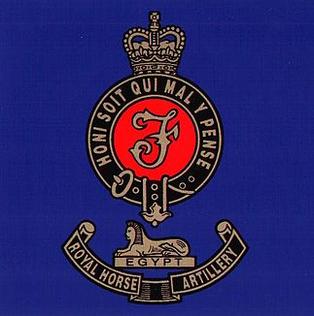
The Royal Horse Artillery (RHA) was formed in 1793 as a distinct arm of the Royal Regiment of Artillery to provide horse artillery support to the cavalry units of the British Army. Although the cavalry link remained part of its defining character, as early as the Battle of Waterloo the RHA was sometimes deployed more along the lines of conventional field artillery, fighting from comparatively fixed positions.

5th Regiment Royal Artillery is a regiment of the Royal Artillery in the British Army. It was formed in 1939 as 5th Regiment Royal Horse Artillery before being redesignated in 1958. It currently serves in the Surveillance and Target Acquisition role and is equipped with radars and acoustic sound ranging equipment; it also provides Special Observation Post teams.
E Battery Royal Horse Artillery is a Close Support Battery of 1st Regiment Royal Horse Artillery. It is currently based in Purvis Lines in Larkhill Camp.
L (Néry) Battery Royal Horse Artillery is the Tactical Group Battery of 1st Regiment Royal Horse Artillery.
J Battery Royal Horse Artillery are a Close Support Battery of 3rd Regiment Royal Horse Artillery. They were currently based in Caen Barracks in Hohne, Germany.
M (Headquarters) Battery Royal Horse Artillery is the Headquarters Battery of 3rd Regiment Royal Horse Artillery, part of the Royal Horse Artillery of the British Army. As of 2015, it is based at Albemarle Barracks, Northumberland, England. The Battery Commander is Maj B Johnston RHA.
N Parachute Battery Royal Horse Artillery is a Tactical Group Battery of 7th Parachute Regiment Royal Horse Artillery. They are currently based in Albemarle Barracks in Northumberland.
P Battery (The Dragon Troop) is a battery of 5th Regiment, Royal Artillery in the Royal Regiment of Artillery. It currently serves in the Surveillance and Target Acquisition role and is equipped with weapon platform locating equipment, which include radar and sound ranging systems.

F (Sphinx) Parachute Battery Royal Horse Artillery is a close support battery of 7th Parachute Regiment Royal Horse Artillery, part of the Royal Horse Artillery of the British Army, currently based in Merville Barracks in Colchester.
6th Regiment, Royal Horse Artillery was a Regiment of the Royal Horse Artillery that acted as a training formation during World War II. It was the last RHA unit to serve in India between December 1945 and April 1947, before being redesignated as 6th Field Regiment, Royal Artillery in Palestine in 1948.
V Brigade, Royal Horse Artillery was a brigade of the Royal Horse Artillery which existed in the early part of the 20th century. It served with 8th Division on the Western Front in World War I before becoming V Army Brigade, RHA in January 1917. It was reformed after the war but was disbanded in October 1928.
III Brigade, Royal Horse Artillery was a brigade of the Royal Horse Artillery which existed in the early part of the 20th century. It served with the 1st and 2nd Cavalry Divisions on the Western Front throughout World War I.
I Brigade, Royal Horse Artillery was a brigade of the Royal Horse Artillery which existed in the early part of the 20th century. It was dissolved at the outbreak of World War I as its constituent batteries were posted to other formations.
G Parachute Battery Royal Horse Artillery is a close support battery of 7th Parachute Regiment Royal Horse Artillery, part of the Royal Horse Artillery of the British Army, currently based in Merville Barracks in Colchester.
I Parachute Battery Royal Horse Artillery is the Headquarters battery of 7th Parachute Regiment Royal Horse Artillery, part of the Royal Horse Artillery of the British Army, currently based in Albemarle Barracks in Newcastle Upon Tyne.
H Battery Royal Horse Artillery is a battery of 1st Regiment Royal Horse Artillery, part of the Royal Horse Artillery of the British Army. As of 2015, it is based at Albemarle Barracks, Northumberland, England and is equipped with GMLRS.
T Battery Royal Artillery is an air defence battery of the Royal Artillery that serves with the British Army's 12 Regiment Royal Artillery. It is stationed at Baker Barracks, Thorney Island, West Sussex.

The 140th Field Regiment, Royal Artillery was a unit of Britain's Territorial Army formed in 1939, just before World War II. During the Battle of France, in 1940, it participated in defending Cassel to protect the British Expeditionary Force's evacuation from Dunkirk. Barely half the men escaped to England, where the regiment was rebuilt. It later served in home defence, in Tunisia, and after conversion to the medium artillery role, in Italy, where it was disbanded.

The 2nd Searchlight Regiment, was an air defence unit of Britain's Royal Artillery formed just before World War II. Deploying to France with the British Expeditionary Force and RAF Advanced Air Striking Force in 1940, it found itself caught up in ground fighting during the Battle of France, including actions at Arras, Boulogne, Calais, and Hondeghem. After the evacuation from Dunkirk it served in home defence in Anti-Aircraft Command until 1944, when it deployed to Europe again, seeing action in the defence of Antwerp and the Scheldt, then the river crossings as 21st Army Group advanced into Germany at the end of the war. It was disbanded in 1948.

The 7th Anti-Tank Regiment was an anti-tank artillery regiment of the New Zealand Military Forces raised during the Second World War. It saw service as part of the 2nd New Zealand Division during the Greek, North African, Tunisian and Italian campaigns, before being disbanded in December 1945.




